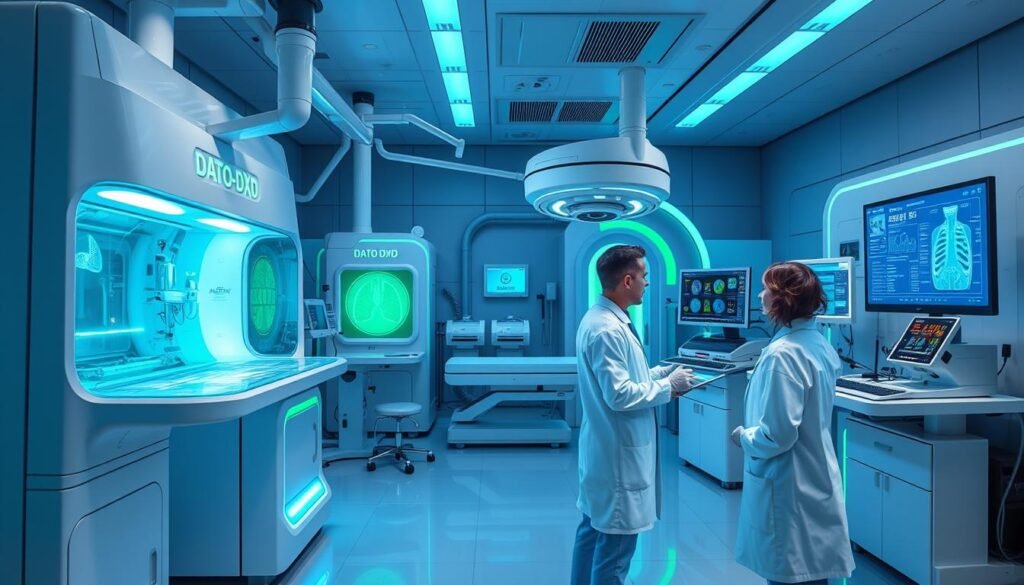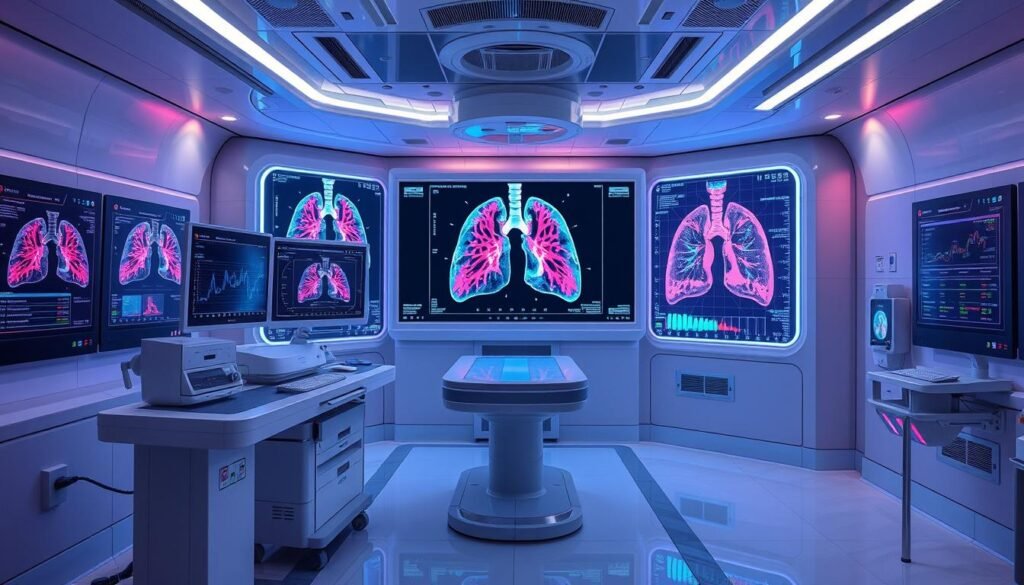Approximately 2.5 million cases of lung cancer were discovered worldwide in 2022. Most of these, about 80%, were diagnosed as nonsquamous non-small cell lung cancer (NSCLC). Detecting EGFR mutations is key for treating 10-15% of patients in the U.S. and Europe, and 30-40% in Asia. This fact underscores the urgent need for specialized treatments.
Datopotamab deruxtecan, or Dato-DXD, is a beacon of hope in lung cancer therapy. This experimental treatment targets tumors that express the TROP2 protein. It’s the result of teamwork between AstraZeneca and Daiichi Sankyo. Dato-DXD opens a door to new possibilities for those with advanced or metastatic lung cancer, particularly for those who’ve tried everything else.
The submission of the biologics license application (BLA) to the FDA for fast-tracked approval marks a crucial leap in combating lung cancer. With the latest data from ongoing research, Dato-DXD is shaping up to be a game-changer. It’s poised to revolutionize our approach to lung cancer treatment.
Key Takeaways
- Approximately 2.5 million lung cancer cases diagnosed globally in 2022.
- Nonsquamous NSCLC represents about 80% of lung cancer cases.
- 10-15% of NSCLC patients in the U.S. and Europe have EGFR mutations.
- Datopotamab deruxtecan is a targeted therapy for advanced lung cancer.
- FDA acceleration is sought for Dato-DXD as a promising treatment option.
Introduction to Dato-DXD and Lung Cancer
Lung cancer is a big health issue, with most cases being non-small cell lung cancer (NSCLC). This type of lung cancer is hard to treat in later stages. Dato-DXD, developed by Daiichi Sankyo and AstraZeneca, brings hope. It is especially useful for advanced lung cancer.
Dato-DXD has shown promise in treating NSCLC, where there’s a big need for new solutions. Studies like TROPION-LUNG01 show exciting outcomes. For example, patients treated with Dato-DXD lived longer compared to those on standard treatments. This progress is key in better lung cancer care.
In one study, Dato-DXD helped 31% of patients with a certain lung cancer type, outperforming an older drug. This highlights the need for treatments that are both effective and easier on the body. With Dato-DXD, there’s new hope for those battling advanced lung cancer.
The way we treat lung cancer is changing, with a focus on tailored treatments like Dato-DXD. It’s important to make sure patients can get these treatments. For more details on Dato-DXD, check this study.
The Significance of Early Detection in Lung Cancer
Early screening for lung cancer is vital in improving patient outcomes. It enables more effective treatment options. This increases survival rates significantly. Low-dose CT scans are key in catching lung cancer early. This boosts the chances of successful treatment.
Spotting small nodules early is crucial for lung cancer diagnosis. This allows for quick action and tailored treatment plans. Robotic bronchoscopy, for example, offers precise diagnosis with fewer complications. This enhances survival chances.
New technologies and methods are advancing lung cancer diagnosis. Research on biomarkers aims to improve treatment effectiveness. Early screening’s skill significantly impacts survival. Studies show patients live longer when cancer is found early and treated right away.
| Screening Method | Effectiveness | Advantages |
|---|---|---|
| Low-Dose CT Scans | High sensitivity in early detection | Non-invasive, quick results |
| Robotic Bronchoscopy | Precise targeting of small nodules | Reduced complications |
| Biomarker Testing | Potential for predicting treatment response | Tailor treatments to individual needs |
Clinical trials are key in improving diagnosis methods. They help find new treatments, especially for advanced cancer. Focusing on early screening leads research forward. The goal is to change how we care for lung cancer.

Understanding Dato-DXD Lung Cancer Treatment
Dato-DXD is a new hope for advanced lung cancer treatment. It effectively targets tumors that show the TROP2 protein, crucial in many non-small cell lung cancer (NSCLC) cases. With the cutting-edge dato-dxd technology, Dato-DXD offers a strong approach. It improves outcomes for patients facing this tough battle.
What is Datopotamab Deruxtecan (Dato-DXD)?
Datopotamab deruxtecan aims at cancer cells showing the TROP2 protein. It’s found in about 80% of lung cancer situations. Daiichi Sankyo and AstraZeneca developed it. The therapy uses new drug delivery ways to be more effective and safe.
Mechanism of Action of Dato-DXD
Dato-DXD connects to the TROP2 protein on cancer cells. After binding, it delivers a toxin to kill the cancer cells. This method helps stop the cancer cells from growing and spreading. Unlike traditional chemotherapy, it causes fewer side effects. It’s a big step forward in lung cancer treatment.

Phase II and Phase III Trials of Dato-DXD
Research on Dato-DXD in lung cancer treatment is ongoing. This includes various clinical trials. These efforts aim to understand its effectiveness and improve care for non-small cell lung cancer (NSCLC). The TROPION-Lung05 and TROPION-Lung01 trials play a key role in this. They provide important data on Dato-DXD outcomes.
TROPION-Lung05: Key Findings
The TROPION-Lung05 trial looked at Dato-DXD’s effects on patients with a specific lung cancer type. It included 137 people who had tried other therapies. The main goal was to see how many responded to the treatment.
It found a response rate of 35.8%, higher in certain mutations at 43.6%. The trial also showed patients lived longer without disease worsening and how long they survived overall.
- Confirmed ORR: 35.8%
- ORR for EGFR mutations: 43.6%
- Median progression-free survival: 5.8 months
- Median overall survival: 15.6 months
TROPION-Lung01: Trial Insights
The TROPION-Lung01 trial provided crucial information. It compared Dato-DXD to standard chemotherapy in advanced NSCLC. With about 600 participants, it showed an improved survival time for Dato-DXD patients.
This marks a significant step forward, especially for patients with certain genetic changes.
| Trial | Median Overall Survival (Months) | Median Progression-Free Survival (Months) | Patients Involved |
|---|---|---|---|
| TROPION-Lung05 | 15.6 | 5.8 | 137 |
| TROPION-Lung01 | 12.9 | Not specified | 600 |
These studies, especially TROPION-Lung05 and TROPION-Lung01, are changing NSCLC treatments. They lay the foundation for new advancements. Click here for more on lung cancer research updates.
Impact of AI Radiology in Lung Cancer Diagnosis
AI radiology marks a big step forward in lung cancer diagnosis. It uses deep learning to spot lung nodules better. This means doctors can find cancer earlier and cut down on mistakes. This leads to faster help for patients.
Role of Deep Learning in Chest CT Imaging
Deep learning has changed how doctors look at chest CTs. It helps them see complex patterns quickly. AI systems make detection faster, saving radiologists’ time. This makes finding lung cancer more accurate.
Studies show that AI could make a huge difference in diagnosis. A 20-year follow-up study praised these tech advancements. Samsung is working on these AI tools too. Their Lunit INSIGHT CXR Triage, approved by the FDA, spots chest x-ray issues. This boosts radiologists’ skills, leading to early cancer detection.
AI in radiology is getting better, helping fight lung cancer with advanced tech. This could save more lives and make healthcare better. For more on AI’s role in cancer care, check out this study.

Computer-Aided Detection and Lung Nodule Classification
Computer-aided detection (CAD) systems boost how doctors find lung cancer. They help radiologists by highlighting potential lung nodules when looking at chest CT scans. This quickens and enhances the accuracy of their reviews.
Many algorithms drive these CAD systems. They are key in figuring out lung nodules. This lung nodule classification helps decide what to do next for patients and their treatment choices.
Adding CAD into regular imaging helps spot cancers sooner. With the use of these systems, the chances of getting better improve. This is because it’s easier to diagnose accurately early on.
The Future of Early Lung Cancer Screening
New tools for early lung cancer screening are changing lives. Studies now focus on better detection methods for those at high risk. They are looking into blood markers and advanced scans for quick and effective diagnosis.
Artificial intelligence (AI) is also playing a big role. AI helps analyze scan results more accurately. This is crucial for catching lung cancer early. New treatment methods are making a big difference in care.
It’s important to screen people who are at high risk properly. Studies show we need good screening plans. People who’ve smoked a lot must follow these plans. For more on screening, check out these important resources.
Putting money into better diagnosis means catching the disease early. This could greatly improve chances of survival. With continued research and new technologies, we’re moving toward a future where early screening could save more lives than ever before.
Benefits of Dato-DXD Over Traditional Treatments
The battle against lung cancer is tough. The benefits of dato-dxd offer new hope. It targets the cancer’s unique traits, focusing on tumors in advanced non-small cell lung cancer (NSCLC). This is a big change from the wide-reaching attack of standard chemotherapies.
The TROPION-Lung01 Phase III trial shed light on Dato-DXD’s impact. It showed patients living longer with Dato-DXD. Their overall survival (OS) was 12.9 months. This is better than the 11.8 months with the common chemotherapy, docetaxel. This improvement highlights the shift towards advanced cancer therapies.
In a specific group, patients with nonsquamous NSCLC, those treated with Dato-DXD lived 2.3 months longer than those who got docetaxel. They also had a better chance of living without the cancer getting worse. Their median progression-free survival (PFS) was 5.6 months, unlike docetaxel’s 3.7 months.
Another plus for Dato-DXD is its safety. Fewer patients had to lower their doses or stop treatment because of side effects. In the TROPION-Lung01 trial, 26% had serious treatment-related side effects with Dato-DXD. This is less than the 42% with docetaxel. Fewer side effects mean a gentler treatment.
In conclusion, Dato-DXD shines as a hopeful choice for lung cancer care. It aims to extend lives and make treatment easier to handle. This focus on better outcomes and quality of life marks a significant move forward.
Conclusion
The introduction of Dato-DXD in treating lung cancer is changing the game, especially for those facing tough battles with the disease. It has shown a median overall survival of 12.9 months. This is better than the 11.8 months seen with older treatments like docetaxel.
Patients also show a median progression-free survival of 4.4 months. This highlights how Dato-DXD can improve patient lives and extend how long they live.
In a specific group of patients, the success of Dato-DXD is even more evident. Their overall response rates jumped to 31.2%. Moreover, when combined with drugs like Imfinzi, response rates skyrocketed to 77%. This opens the door to more personalized treatment plans.
The future of lung cancer treatment relies on the combination of Dato-DXD, AI, and the latest imaging technologies. Catching the disease early is key to beating lung cancer. With ongoing research, we’re hopeful for more effective treatments. These could lead to better outcomes for patients facing this difficult disease.